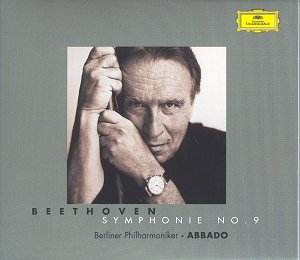The changes in the playing and the sound of the great
Berlin Philharmonic that have come about since Claudio Abbado took over
are demonstrated strikingly in the opening bars of this fine version
of the 9th Symphony. As compared with Karajan’s days, the
sound is clear, precise; every demi-semiquaver is articulated, details
in the orchestration that used to be lost behind swathes of string sound
now emerge with ease, and, above all, the attack is hard-edged (where
appropriate); Karajan liked even sforzandi to possess an elegant
roundness, a sort of unanimous, controlled lack of precision – a paradox,
I know, but an undoubted feature of Karajan’s distinctive approach.
That has gone, now, and the effect is bracing. There
is also a smaller scale to the sound, tighter and more in keeping with
Beethoven’s era. The overall result is closer to chamber music on a
grand scale, which is what it should be, of course. This isn’t to say
that this reading is under-powered; the recapitulation of the main theme
(Track 1 around 7:45) is thunderously impressive, all the more so as
it follows on from the intimacy of the preceding woodwind exchanges.
One passage struck me as a fine example of the gains of Abbado’s method;
in the coda, there is a wonderful moment where the strings take up a
phrase from the first subject, building it to forte and back
down again (Track 1, 12:20 to 12:50). Throughout, little semiquaver
phrases are tossed back and forth between woodwind soloists. In every
other performance I have heard, whether live or on disc, these phrases
become lost as the strings grow louder; not here – every one is audible,
so fine is Abbado’s ear for balance.
Comparing the Scherzo with Karajan’s 1962 version
was revealing. Karajan is faster (not by much) in the main sections,
but Abbado much quicker in the Trio, where he risks pushing the music
– certainly the first horn sounds a little less than comfortable in
his solo. Similarly in the slow movement, where many conductors broaden
out for the lovely second theme (call this the post-Brucknerian approach
if you like!), Abbado presses on, refusing to let the music lose its
forward motion. Again, here and there, the players sound a little rushed,
as if they would like more time to shape the phrases lovingly. The orchestra
is too fine for the ensemble to become ragged, but the whole thing is
clearly a learning curve for them, too. The pay-off is that the structure
of the movement becomes more lucid, but maybe just a little of the mystery
of that sublime coda goes missing.
In the finale, many of the same virtues are present.
The most striking aspect of the performance is the presentation of the
‘Joy’ theme in the ‘celli and basses. Abbado asks them to play so softly
that they are virtually inaudible, a risky ploy. I can see his reason;
this theme is now, sadly, too well-known for its own good - a conductor
must somehow catch the significance of its appearance, and in a live
performance, I can see that this could be wonderfully effective. The
danger in a recording is that it will have the listener simply diving
for the volume control, only to be blown out of his/her seat a few minutes
later!
Abbado has assembled an excellent team of soloists;
Quasthoff is quite splendid in his first recitative and presents the
theme in an ideal way. Not so convincing is the tenor, Thomas Moser,
who sounds a little out of breath in his marching solo, and produces
a disappointing high Bb. The soprano Karita Mattila, is good, but in
the famous quartet near the end, sounds rushed with her phrases, and
her high B is less than top-notch. Again harking back to 1962, Karajan
of course had then the incomparable Gundula Janowitz, whose phrasing
of this passage, and the way she approaches the climactic high note,
is a model for any singer – stunning!
If you are tempted to dismiss Abbado as a speed-merchant,
just remember that the same objections were raised to Karajan’s performances
in earlier days, not to mention Norrington’s, and listen to the comparatively
sedate tempo Abbado adopts for the great double-fugue in the finale.
This is part of a grand plan which allows him to graduate the changes
of tempo highly effectively, concluding with the final breathless charge.
Is there such a thing as a perfect ‘Choral’? Probably
not; but this is a particularly fine one, which I suspect will stand
the test of time. As a performance, it steers a convincing path between
more traditional approaches and ‘period’ versions of more recent times.
Gwyn Parry-Jones


![]() See
what else is on offer
See
what else is on offer 